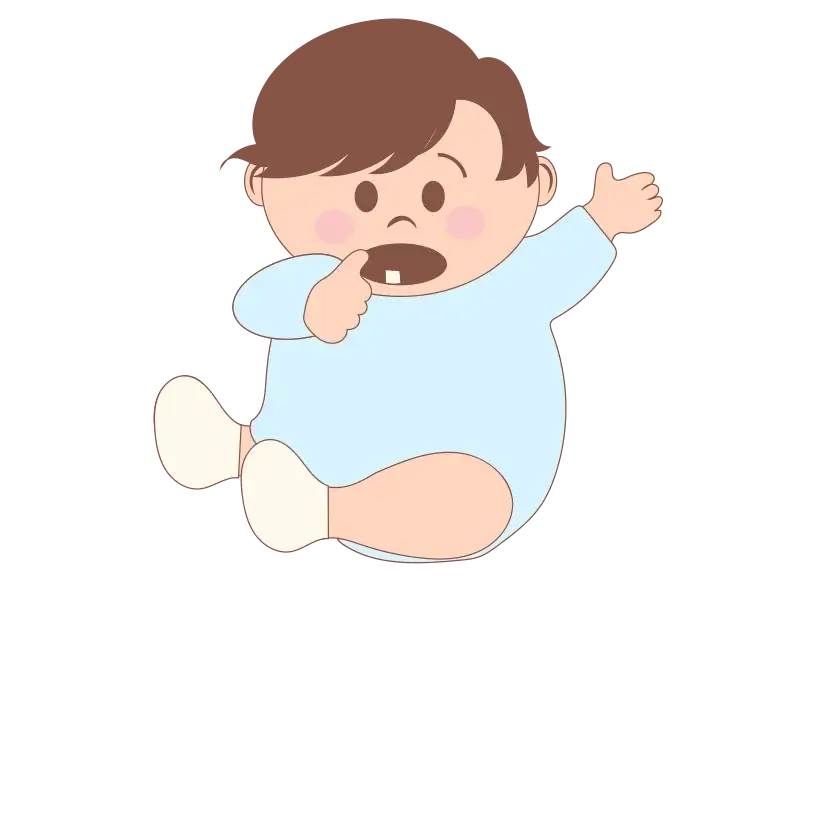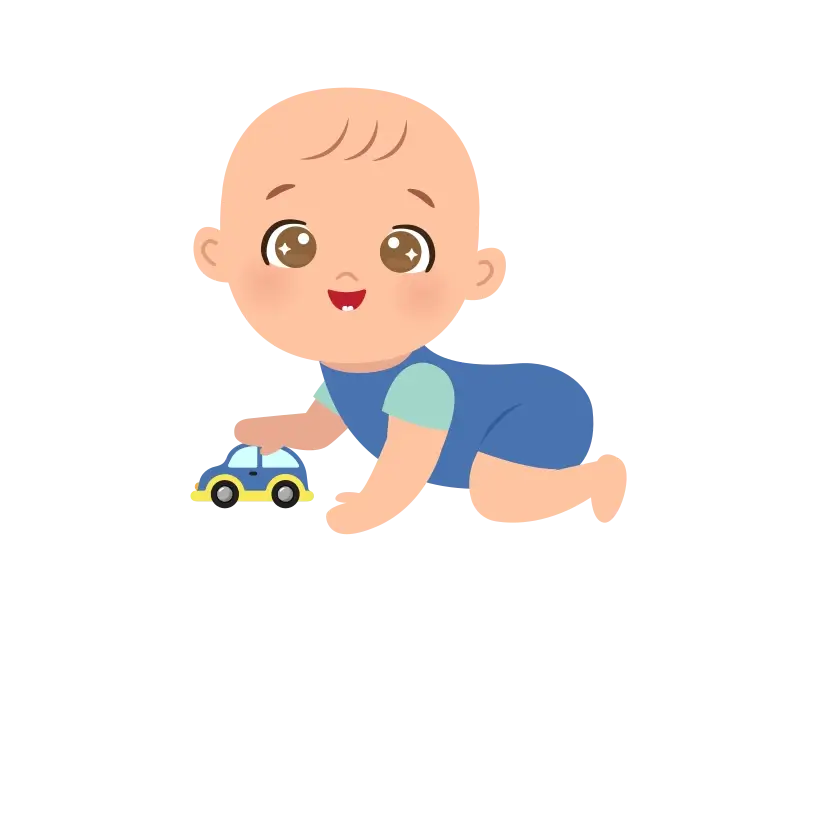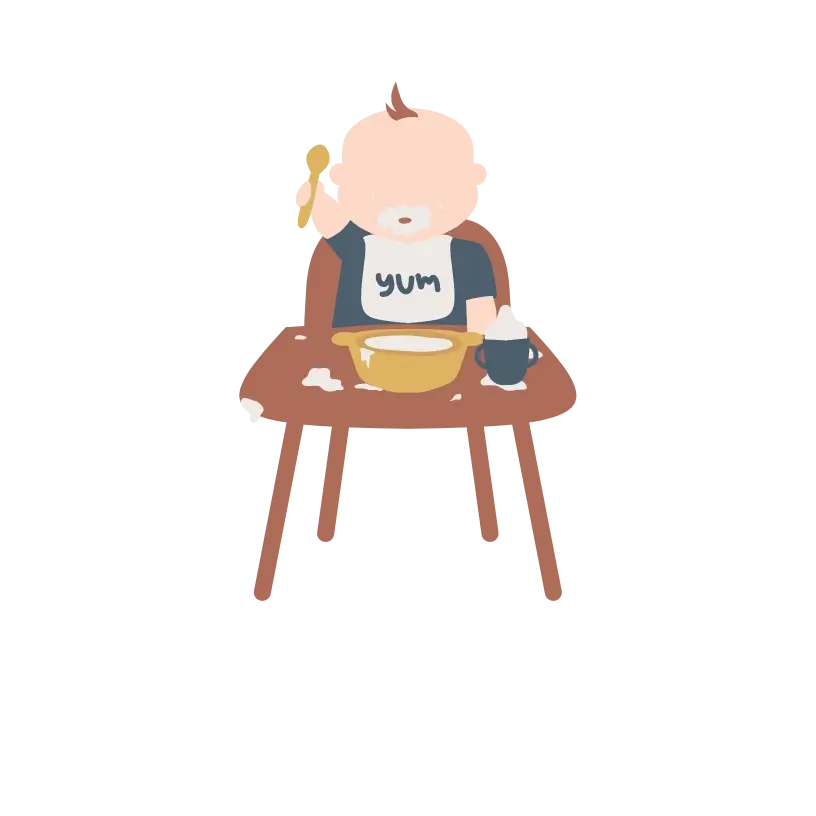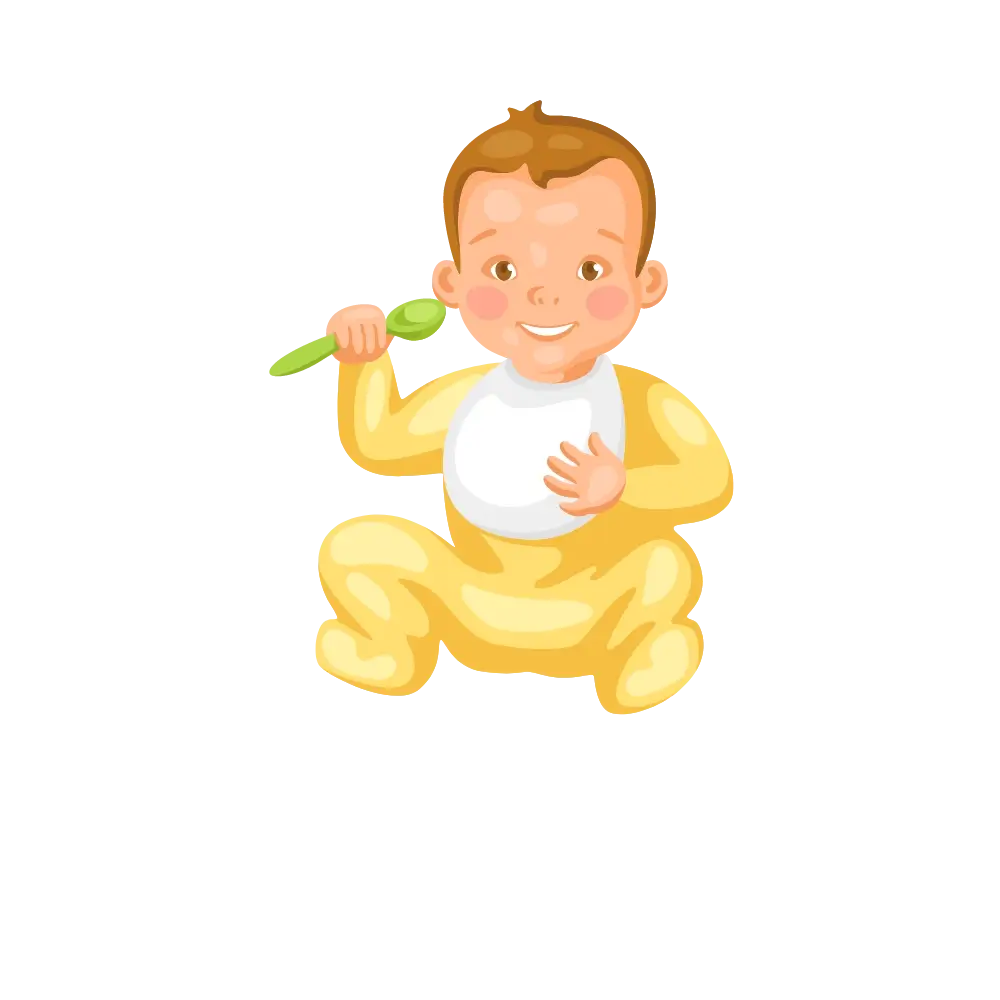Menu

It’s an exciting time as your 7-month-old develops a better understanding of the world, sees in full colour, tracks objects, and experiences new milestones.
Be prepared for the onset of separation anxiety, where your baby might cry and cling when you’re heading out without them. Here’s what else to expect during this stage of development.
Your baby is growing up, and now they love talking and playing with family! They’re so happy it’s contagious—you might laugh with them.
Did you know that some babies recognize their names at seven months? Even though people don’t talk about it often, it’s a cool social skill for them. So, say your baby’s name often, especially during games and reading books. Most babies love hearing their name and will give you a big grin. It’s a fun way for them to learn and connect with you!
According to the World Health Organization, a 7-month-old baby weighs around 16.8 pounds for girls and 18.3 pounds for boys, with an average length of 26.5 inches for girls and 27.2 inches for boys. It’s important to note that these are averages, and there can be variations among healthy babies.
It’s crucial not to get too focused on the “normal” weight. Babies can differ in height and weight. As long as your baby is growing steadily, following a healthy curve on the growth chart at the doctor’s office, and your pediatrician doesn’t notice any concerning signs, your baby’s growth is considered on track. It’s more about the overall growth pattern rather than hitting specific weight or height milestones at this stage.
If your 7-month-old is still sporting a toothless grin, don’t fret—those adorable pearly whites might appear soon. Usually, the first teeth to show up are the bottom incisors, followed by the top ones. It’s a normal part of your baby’s development, and before you know it, their gummy smile will transform into an even more charming one with those first little teeth. Watch for teething signs like drooling and fussiness, and be ready for some adorable toothy grins shortly!
Babies develop at different rates, and it’s normal.
When your baby turns seven months, it’s advisable to discuss concerns with your doctor or maternal child health nurse if you notice:
As you navigate this month, you’re probably still introducing new foods and textures to your little one. Remember, there’s no need to rush; some babies may adjust to solid foods at a slower pace, and that’s perfectly okay. Every baby is different, so pay attention to your baby’s cues and preferences.
As your 7-month-old grows new teeth, it’s a good time to transition to chunkier foods. Consider switching from pureed to mashed fruits and vegetables and introducing new items to expand your baby’s palate.
For a balanced diet, aim for four to nine tablespoons of cereals, fruits, and veggies, focusing on colourful options like butternut squash and sweet potatoes to provide essential nutrients for brain development.
Despite these explorations, remember that your baby’s primary source of nutrition remains breastmilk or formula.
They’ll likely still nurse or have formula bottles four to six times daily, about 24 to 30 ounces. This seventh month serves as a transition period, paving the way for the months ahead when solid foods will become a more significant part of their nutrition while maintaining the importance of breastmilk or formula.
At seven months, it’s an opportune time to introduce solid foods to your baby gradually. If you’re wondering about what to include in your baby’s diet and how much, consider the following tips and insights:
You have the flexibility to decide what to feed your 7-month-old. Focus on nutritious, unprocessed options, and purees like mashed fruits, veggies, and whole grain baby cereal are excellent choices as your baby begins solid foods. It’s a great opportunity to explore different flavours and textures based on your baby’s preferences. Here are some nutritious options:
When considering baby finger foods, look for soft, small options that are easy to gum. Here are some great choices to kickstart your baby’s finger food journey, even if they don’t have teeth yet!
Typically, a seven-month-old baby sleeps around 14 hours daily, comprising two to three naps and nine to 11 nighttime hours. Yet, a total sleep duration between 12 and 16 hours is within the normal range. Expect shifts in sleep patterns as your baby grows, including waking earlier, adjusting nap times, or showing interest in staying up a bit later – all of which are considered normal developments.
Wake Windows: Pay attention to wake windows or when your baby is awake between naps. In the morning, the wake window is shorter (around 2 hours), gradually increasing throughout the day. The longest wake window is usually before bedtime (2.75 – 3.5 hours), depending on the number of naps taken.
Bedtime and Nap Routines: Establish predictable routines to signal your baby that it’s time for sleep. This routine may include bathing, reading a book, or listening to calming music. Consistency is key to creating a sleep-friendly environment.
Offer 3 naps a few times per week: If your baby has transitioned to 2 naps and you’re suddenly seeing increased night waking (or early morning wakings), overtiredness may be to blame. Offer 3 naps two to three times per week to help “reset” their overtiredness and get them back on track.
Teach Sleep Independence: Encourage your baby to fall asleep independently without external help, such as patting or rocking. Babies who develop this skill are more likely to sleep longer stretches and link sleep cycles during the night.
Keep the Bedroom Dark: Create a dark sleep environment to minimize distractions and encourage longer naps and later wakeups. Darkness signals to your baby that it’s time
The seventh month is a remarkable time in your baby’s development as their senses become more refined and responsive. Understanding and fostering their growing abilities to see, touch, and explore the world around them can be a delightful and rewarding experience.

At seven months, your baby’s eyesight has progressed significantly. They can now see across the room and enjoy vibrant colours almost as well as you do. To stimulate their visual senses, provide bright-coloured toys, introduce varied textures in playthings and stuffed animals, and place them in front of a mirror. The mirror reflects their image and sparks curiosity, creating a delightful visual experience

By seven months, your baby’s hearing is well-developed and may respond to familiar voices and sounds. Encourage their auditory senses by introducing gentle music, singing, and narrating stories. Toys that produce soft sounds or crinkly textures can captivate their interest, creating a delightful auditory experience.

Engaging your baby’s sense of touch involves incorporating different textures into their daily experiences. Offer toys with various surfaces, allowing them to feel and explore. Touch-and-see or lift-and-see books are excellent tools, enabling your baby to discover diverse textures while exploring colours and pictures. Playing peek-a-boo with lift-and-see books adds an interactive touch, fostering both sensory engagement and joy.

As you gradually introduce solid foods, your baby’s sense of taste becomes active in their sensory journey. Offer a variety of flavours, allowing them to explore different tastes. Pay attention to their preferences, as this helps create a positive association with food during this crucial developmental stage.

Your baby becomes more attuned to different smells while exploring the world. Incorporate scents into their environment, such as introducing them to the aroma of fresh fruits or flowers during playtime. This gentle exposure contributes to their sensory awareness and adds another layer to their growing perceptual abilities.

At seven months, your baby’s eyesight has progressed significantly. They can now see across the room and enjoy vibrant colours almost as well as you do. To stimulate their visual senses, provide bright-coloured toys, introduce varied textures in playthings and stuffed animals, and place them in front of a mirror. The mirror reflects their image and sparks curiosity, creating a delightful visual experience.

By seven months, your baby’s hearing is well-developed and may respond to familiar voices and sounds. Encourage their auditory senses by introducing gentle music, singing, and narrating stories. Toys that produce soft sounds or crinkly textures can captivate their interest, creating a delightful auditory experience.

Engaging your baby’s sense of touch involves incorporating different textures into their daily experiences. Offer toys with various surfaces, allowing them to feel and explore. Touch-and-see or lift-and-see books are excellent tools, enabling your baby to discover diverse textures while exploring colours and pictures. Playing peek-a-boo with lift-and-see books adds an interactive touch, fostering both sensory engagement and joy.

As you gradually introduce solid foods, your baby’s sense of taste becomes active in their sensory journey. Offer a variety of flavours, allowing them to explore different tastes. Pay attention to their preferences, as this helps create a positive association with food during this crucial developmental stage.

Your baby becomes more attuned to different smells while exploring the world. Incorporate scents into their environment, such as introducing them to the aroma of fresh fruits or flowers during playtime. This gentle exposure contributes to their sensory awareness and adds another layer to their growing perceptual abilities.
Understanding your seven-month-old’s cues is crucial for addressing their needs. Signs of discomfort include:
As your baby turns seven months old, you’ll notice increased activity and a greater need for hands-on care. Their growing mobility and newfound skills will have them actively exploring the world around them.

Achieving the milestone of sitting independently is not merely a display of physical prowess but a testament to your baby’s enhanced muscle strength in their back and core. This newfound ability opens up a new perspective for exploration, allowing them to engage with their surroundings from a seated position, fostering physical and cognitive development.

While not fully standing independently, your baby’s capacity to pull up to a standing position with assistance showcases the gradual development of leg strength and coordination. This achievement lays the groundwork for future milestones in standing and walking, highlighting the ongoing progression of their motor skills.

Vocal development takes centre stage during this phase as your baby explores diverse sounds. Imitating sounds they hear becomes a significant milestone, setting the stage for language development and communication skills as they engage with their auditory environment.

The playful game of peek-a-boo becomes more interactive as your baby grasps the concept of object permanence. This cognitive development is not just about hiding and revealing but a profound understanding that objects (or people) continue to exist even when temporarily out of sight, eliciting joyous reactions during play and contributing to their cognitive growth.

As your baby’s fine motor skills develop, clapping their hands becomes a form of expression. This involves hand-eye coordination and intentional movement, showcasing their growing ability to engage with and manipulate their environment.

Progressing to finger foods is a delightful step that signifies developing pincer grasp and hand-eye coordination. This newfound skill empowers your baby to explore self-feeding, fostering a sense of independence during meals and encouraging further fine motor development.

The first tooth’s emergence is a momentous occasion in your baby’s physical development. While it may be the lower central incisors making their debut, this event sets the stage for a series of dental milestones, emphasizing the importance of oral health from an early age.

Initiating a gentle tooth brushing routine with a baby-friendly toothbrush ensures good oral hygiene and establishes positive habits for the future. This early introduction to dental care contributes to your baby’s overall health and well-being.

The ability to transfer objects between hands signifies a leap in fine motor skills. This showcases growing coordination and control over their movements, enhancing their ability to interact purposefully with the objects in their environment.

Engaging in the activity of banging objects on surfaces goes beyond mere play. It becomes a crucial exploration of cause and effect, contributing to both motor skill development and cognitive understanding as your baby discovers the impact of their actions on the world around them.

Developing visual acuity allows your baby to focus on smaller objects. This marks improvements in their vision and indicates a growing attention to detail, contributing to their overall cognitive and sensory development.

Social and cognitive development take centre stage as your baby begins to respond to their name. This responsiveness reflects a growing recognition and connection with their own identity, fostering a sense of social awareness and communication.

The beginning awareness of depth and space represents a milestone in your baby’s spatial cognition. As they start perceiving objects in three dimensions, their understanding of their surroundings becomes more nuanced, contributing to their overall spatial intelligence.

As you introduce various solid foods, your baby forms taste preferences. Expressing likes or dislikes for specific flavours and textures contributes to developing their palate, showcasing their evolving culinary preferences and their individuality in the realm of taste.

Achieving the milestone of sitting independently is not merely a display of physical prowess but a testament to your baby’s enhanced muscle strength in their back and core. This newfound ability opens up a new perspective for exploration, allowing them to engage with their surroundings from a seated position, fostering physical and cognitive development.

While not fully standing independently, your baby’s capacity to pull up to a standing position with assistance showcases the gradual development of leg strength and coordination. This achievement lays the groundwork for future milestones in standing and walking, highlighting the ongoing progression of their motor skills.

Vocal development takes centre stage during this phase as your baby explores diverse sounds. Imitating sounds they hear becomes a significant milestone, setting the stage for language development and communication skills as they engage with their auditory environment.

The playful game of peek-a-boo becomes more interactive as your baby grasps the concept of object permanence. This cognitive development is not just about hiding and revealing but a profound understanding that objects (or people) continue to exist even when temporarily out of sight, eliciting joyous reactions during play and contributing to their cognitive growth.

As your baby’s fine motor skills develop, clapping their hands becomes a form of expression. This involves hand-eye coordination and intentional movement, showcasing their growing ability to engage with and manipulate their environment.

Progressing to finger foods is a delightful step that signifies developing pincer grasp and hand-eye coordination. This newfound skill empowers your baby to explore self-feeding, fostering a sense of independence during meals and encouraging further fine motor development.

The first tooth’s emergence is a momentous occasion in your baby’s physical development. While it may be the lower central incisors making their debut, this event sets the stage for a series of dental milestones, emphasizing the importance of oral health from an early age.

Initiating a gentle tooth brushing routine with a baby-friendly toothbrush ensures good oral hygiene and establishes positive habits for the future. This early introduction to dental care contributes to your baby’s overall health and well-being.

The ability to transfer objects between hands signifies a leap in fine motor skills. This showcases growing coordination and control over their movements, enhancing their ability to interact purposefully with the objects in their environment.

Engaging in the activity of banging objects on surfaces goes beyond mere play. It becomes a crucial exploration of cause and effect, contributing to both motor skill development and cognitive understanding as your baby discovers the impact of their actions on the world around them.

Developing visual acuity allows your baby to focus on smaller objects. This marks improvements in their vision and indicates a growing attention to detail, contributing to their overall cognitive and sensory development.

Social and cognitive development take centre stage as your baby begins to respond to their name. This responsiveness reflects a growing recognition and connection with their own identity, fostering a sense of social awareness and communication.

The beginning awareness of depth and space represents a milestone in your baby’s spatial cognition. As they start perceiving objects in three dimensions, their understanding of their surroundings becomes more nuanced, contributing to their overall spatial intelligence.

As you introduce various solid foods, your baby forms taste preferences. Expressing likes or dislikes for specific flavours and textures contributes to developing their palate, showcasing their evolving culinary preferences and their individuality in the realm of taste.
Here are some activities to encourage the development of your seven-month-old:
Yes, introducing breast milk or formula to solid foods, such as iron-fortified infant cereals, is proven effective for several reasons. By blending breast milk or formula with these foods, you create a familiar taste and texture that babies find more palatable. This is particularly beneficial during the initial stages of introducing solids when your baby adjusts to new flavours and consistencies. For instance, adding breast milk or formula to iron-fortified infant cereals can create a smoother, thinner consistency that aligns with your baby’s familiarity with liquids, making the transition to solid foods more gradual and comfortable for them. It ensures they receive essential nutrients while encouraging acceptance of a broader range of foods.
Around the age of 7 months, it’s not uncommon for babies to achieve longer stretches of nighttime sleep, sometimes spanning 10 to 12 hours. If your little one has reached the milestone of pulling up in the crib, it becomes essential to prioritize safety by removing mobiles and hanging toys. This adjustment helps create a secure sleep environment as your baby becomes more active during sleep
At seven months, your baby is in the early stages of being introduced to solid foods. They can consume various pureed fruits, vegetables, and meats and may also try softened table foods. It’s important to refrain from giving babies honey and cow’s milk and to avoid providing round and hard items that pose a choking risk, such as grapes, hot dogs, and raw carrots.
No, a seven-month-old baby is not developmentally ready to engage in any form of walk. At this age, babies are focused on essential milestones such as motor skills, language development, and exploring their surroundings. They require care, attention, and a supportive environment to foster their growth and well-being.
Achieving the milestone of sleeping through the night is a gradual process that your child will eventually reach. Patience and a conducive sleep environment are key factors in encouraging longer periods of sleep for your little one. Around 7 months, your baby might begin sleeping for more extended blocks consistently. While it takes time to string together multiple nights of extended sleep, you can expect a gradual improvement over time.
Yes, introducing breast milk or formula to solid foods, such as iron-fortified infant cereals, is proven effective for several reasons. By blending breast milk or formula with these foods, you create a familiar taste and texture that babies find more palatable. This is particularly beneficial during the initial stages of introducing solids when your baby adjusts to new flavours and consistencies. For instance, adding breast milk or formula to iron-fortified infant cereals can create a smoother, thinner consistency that aligns with your baby’s familiarity with liquids, making the transition to solid foods more gradual and comfortable for them. It ensures they receive essential nutrients while encouraging acceptance of a broader range of foods.
Around the age of 7 months, it’s not uncommon for babies to achieve longer stretches of nighttime sleep, sometimes spanning 10 to 12 hours. If your little one has reached the milestone of pulling up in the crib, it becomes essential to prioritize safety by removing mobiles and hanging toys. This adjustment helps create a secure sleep environment as your baby becomes more active during sleep
No, a seven-month-old baby is not developmentally ready to engage in any form of walk. At this age, babies are focused on essential milestones such as motor skills, language development, and exploring their surroundings. They require care, attention, and a supportive environment to foster their growth and well-being.
At seven months, your baby is in the early stages of being introduced to solid foods. They can consume various pureed fruits, vegetables, and meats and may also try softened table foods. It’s important to refrain from giving babies honey and cow’s milk and to avoid providing round and hard items that pose a choking risk, such as grapes, hot dogs, and raw carrots.
Achieving the milestone of sleeping through the night is a gradual process that your child will eventually reach. Patience and a conducive sleep environment are key factors in encouraging longer periods of sleep for your little one. Around 7 months, your baby might begin sleeping for more extended blocks consistently. While it takes time to string together multiple nights of extended sleep, you can expect a gradual improvement over time.
1. American Academy of Pediatrics: Starting Solid Food
2. British Columbia HealthLinkBC: Finger foods for babies 6-12 months
3. Healthy Children: Sleeping Through the Night
4. Huckleberry: 7-month-old sleep schedule: Bedtime and nap schedule
5. Nemours Kidshealth: Food Allergies
© Mindsmaking 2024